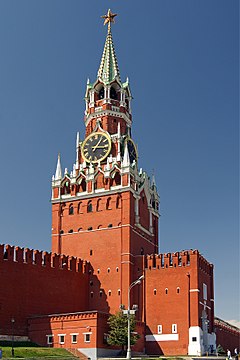Spasskaya Tower
| The Spasskaya Tower | |
|---|---|

The Spasskaya Tower
|
|
| General information | |
| Location | Moscow, Russia |
| Height | 71 metres (233 ft) |
The Spasskaya Tower (Russian: Спасская башня, translated as "Saviour Tower") is the main tower with a through-passage on the eastern wall of the Moscow Kremlin, which overlooks the Red Square.
The Spasskaya Tower was built in 1491 by the Italian architect Pietro Antonio Solari. Initially, it was named the Frolovskaya Tower after the Church of Frol and Lavr in the Kremlin (no longer there). The tower's modern name comes from the icon of Spas Nerukotvorny (The Saviour Not Made by Hands), which was placed above the gates on the inside wall in 1658 (it was removed in 1917) and the wall-painted icon of Spas Smolensky (Smolensky Saviour), which was created in the 16th century on the outside wall of tower (plastered over in 1937, reopened and restored in 2010). The Spasskaya Tower was the first one to be crowned with the hipped roof in 1624–1625 by architects Bazhen Ogurtsov and Christopher Galloway (a Scottish architect and clockmaker). According to a number of historical accounts, the clock on the Spasskaya Tower appeared between 1491 and 1585. It is usually referred to as the Kremlin chimes (Кремлёвские куранты) and designates official Moscow Time.
The tower gate was once the main entrance into the Kremlin. In tsarist times, anyone passing through the gates had to remove their headgear and dismount their horses. This tradition was broken in the Soviet era. Cars approached the gate head on from the place of skulls and the road beside the GUM department store. In order to pass through the gate, you had to be a head of state, top politburo member, or top government member. All other traffic was routed through the borovistky gate. The Spassky Gate posed an issue following the collapse of communism. In the new capitalist and market-based economy, the passage of vehicles disrupted the flow of pedestrians to GUM and other shopping centers, even though few vehicles actually passed through the gate each day. In 1999, the decision was made to finally close the gate to all traffic. The signal lights and guard platforms still remain. The gate is used occasionally when repairs must be made to the borovissky gate. However, in that case, all traffic is routed from vasilievsky spusk. Nowadays, the gate opens to receive the presidential motorcades on inauguration day, for the victory parades, and to receive the new years tree.
...
Wikipedia
